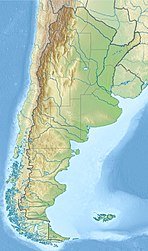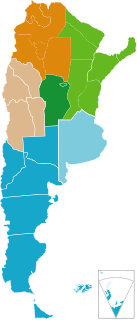
Argentina has a vast territory and a variety of climates and microclimates ranging from tundra and polar in the south to the tropical climate in the north, through a vast expanse of temperate climate. Natural wonders include the Aconcagua, the highest mountain in the world outside the Himalayas, the widest river and estuary of the planet, the Iguazú Falls, the Humid Pampas, and the Argentine Sea. Visitors enjoy the culture, customs and Argentine cuisine.

Jujuy is a province of Argentina, located in the extreme northwest of the country, at the borders with Chile and Bolivia. The only neighbouring Argentine province is Salta to the east and south.

San Salvador de Jujuy, Jujuy, Argentina, commonly known as Jujuy and locally often referred to as San Salvador, is the capital city of Jujuy Province in northwest Argentina. Also, it is the seat of the Doctor Manuel Belgrano Department. It lies near the southern end of the Humahuaca Canyon where wooded hills meet the lowlands.

The Argentine Northwest is a geographic and historical region of Argentina composed of the provinces of Catamarca, Jujuy, La Rioja, Salta, Santiago del Estero and Tucumán.
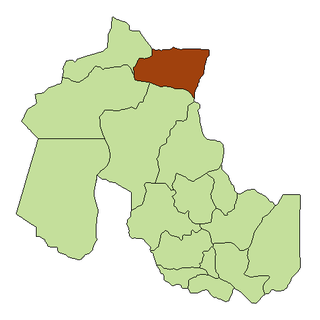
La Quiaca is a small city in the north of the province of Jujuy, Argentina, on the southern bank of the La Quiaca River, opposite the town of Villazón, Bolivia. It lies at the end of National Route 9, 289 km (180 mi) from San Salvador de Jujuy, and at an altitude of 3,442 m (11,293 ft) above mean sea level.

San Francisco de Tilcara is a city in the province of Jujuy, Argentina, and the head town of the Tilcara Department. It had 6,249 inhabitants at the 2010 census [INDEC]. Traces of human habitation in the area date back more than 10,000 years, making it one of the oldest continuously inhabited settlements of Argentina.
The Second Malón de la Paz was a protest march of aboriginals of northwestern Argentina, demanding the restitution of their ancient lands. It started on 7 August 2006 in the province of Jujuy.

Humahuaca is a small city in the province of Jujuy, Argentina. Since 2003 declared World Heritage Site by UNESCO at the Paris conference. It has 11,369 inhabitants as per the 2001 census [INDEC], and is the principal town (seat) of the Department of Humahuaca. The city is widely known for its location at the Quebrada de Humahuaca, along the Eastern valley of the central Andean Altiplano.

Liliana Beatriz Fellner is an Argentine politician. She was a National Senator representing Jujuy Province from 2005 to 2017, and a National Deputy elected in the same province from 2003 to 2005.
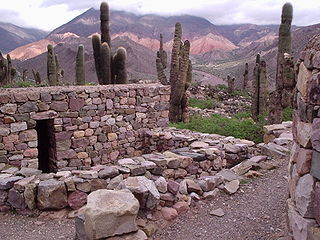
The Pucará de Tilcara is a pre-Inca fortification or pukara located on a hill just outside the small town of Tilcara, in the Argentine province of Jujuy. The location was strategically chosen to be easily defensible and to provide good views over a long stretch of the Quebrada de Humahuaca.

Juan Bautista Ambrosetti was an Argentine archaeologist, ethnographer and naturalist who helped pioneer anthropology in his country.
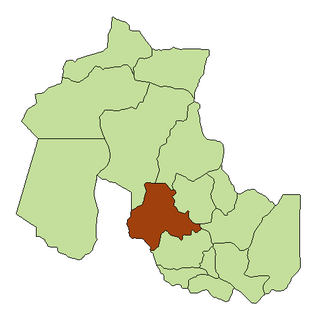
Purmamarca is a town in the Tumbaya Department of the Jujuy Province in Argentina.

Eric Boman was a Swedish Argentine archaeologist.
The Calchaquí or Kalchakí were a tribe of South American Indians of the Diaguita group, now extinct, who formerly occupied northern Argentina. Stone and other remains prove them to have reached a high degree of civilization. Under the leadership of Juan Calchaquí they offered a vigorous resistance to the first Spanish colonists coming from Chile.

Iturbe is a town north of the Quebrada de Humahuaca in the Jujuy Province, Argentina. It is located in the Humahuaca Department, 161 km from the city of San Salvador de Jujuy at a height of 3223 meters. It is also known under the names of Hipolito Yrigoyen and Negra Muerta.
Humahuaca (Omaguaca) is an extinct and unclassified language of Argentina. Tribal and possibly dialect divisions were Fiscara, Jujuy, Ocloya, Osa, Purmamarca, and Tiliar. Mason (1950) proposed that Humahuaca was related to Diaguita (Cacán) and Kunza in a group he called "Ataguitan", but modern sources leave it unclassified due to a lack of data.

Cerro de los Siete Colores is one of the hills bordering the Quebrada de Purmamarca which is in turn is a western branch of the Quebrada de Humahuaca up to Cuesta del Lipán, in Jujuy Province, Argentina.
Its unique color range is the product of a complex geological history including marine sediments, lake and river movements elevated with the movement of the tectonic plates.

The Serranía de Hornocal are a range of mountains located 25 kilometres (16 mi) from the city of Humahuaca in the Argentine province of Jujuy. Exposed in the range is the limestone formation called Yacoraite that extends from Salta, Argentina, through the Argentine Quebrada de Humahuaca and then through the Bolivian Altiplano to Peru.

